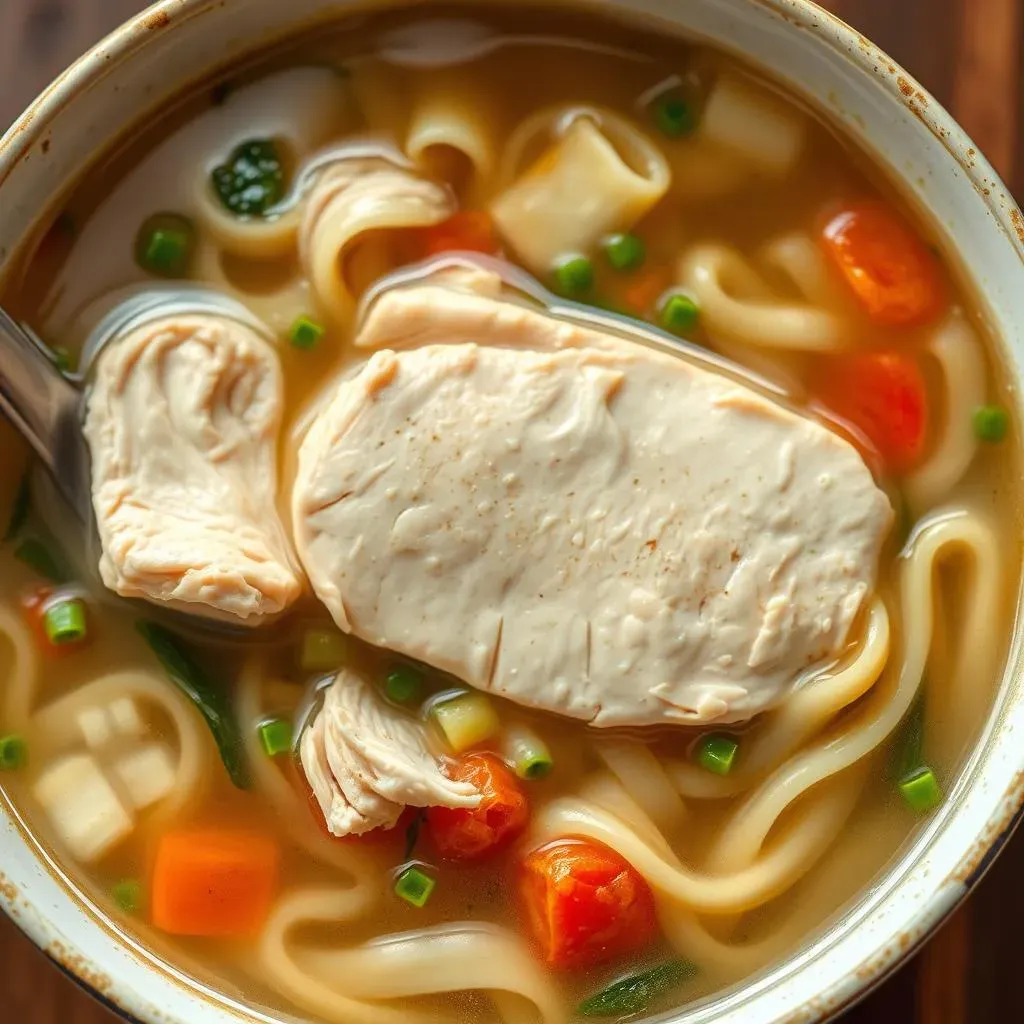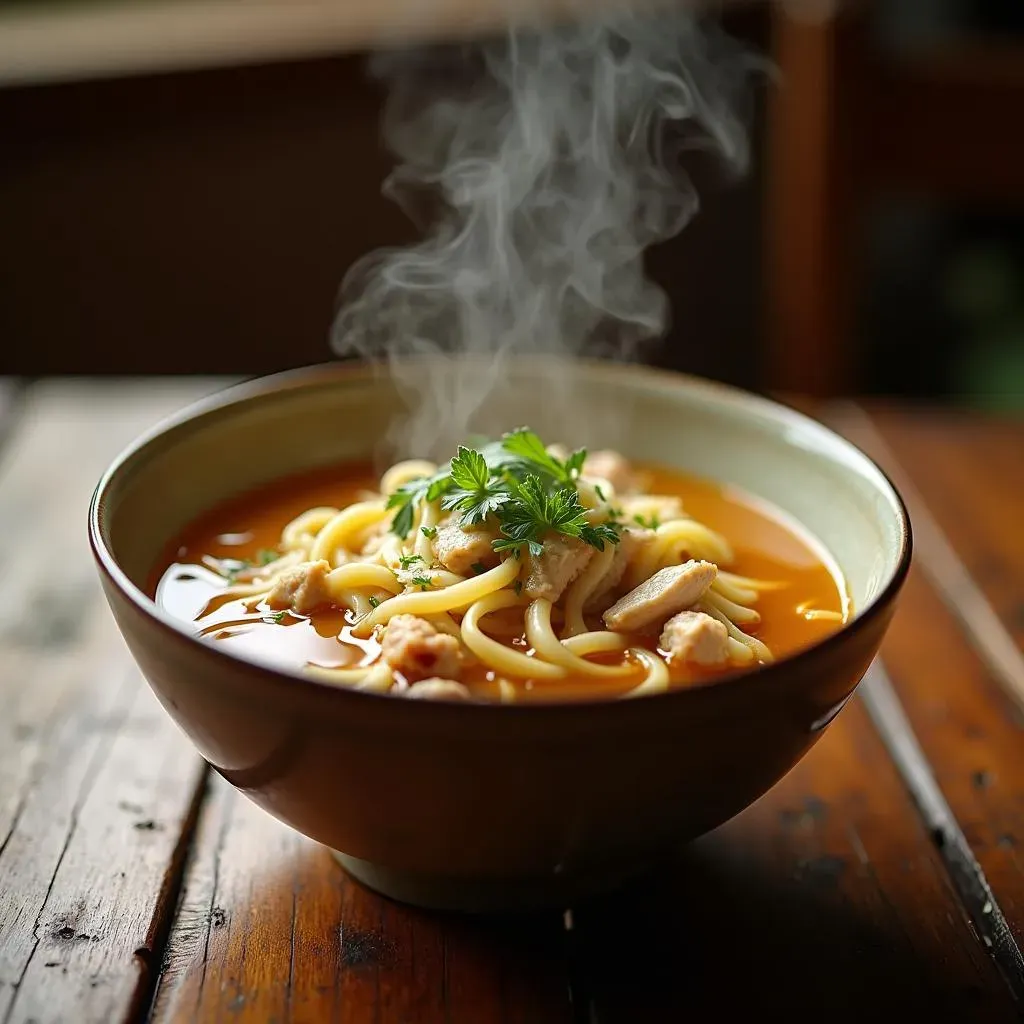Table of Contents
Feeling under the weather or just craving a warm, comforting bowl? Chicken noodle soup is a classic, but it's not always the best choice if you're watching your fat intake. That's where this article comes in! We're going to show you how to enjoy all the goodness of chicken noodle soup without the extra fat. Forget those heavy, creamy versions. We're talking about a light, flavorful, and satisfying chicken noodle soup for low-fat diets. Think tender chicken, soft noodles, and plenty of veggies, all swimming in a clear, delicious broth. We'll explore why this soup is a great choice for a low-fat plan, give you a step-by-step guide to making your own perfect bowl, and even offer some fun ways to change it up. So, grab a spoon, settle in, and get ready to discover the joys of a healthier chicken noodle soup. We'll cover why it's a good choice, how to make it, and ways to make it your own. Let’s get cooking!
Why Chicken Noodle Soup Fits a LowFat Diet

Why Chicken Noodle Soup Fits a LowFat Diet
Okay, so you're thinking about low-fat eating, and maybe the idea of chicken noodle soup seems a bit… off-limits? I get it. But here's the thing: chicken noodle soup can totally be your friend on a low-fat journey. It's all about how you make it! Forget those creamy, heavy versions that are loaded with butter and fat. We're talking about a lighter, broth-based soup that's packed with goodness and not a lot of fat. The key is that the base is a clear broth, not a creamy sauce. That alone cuts down on tons of fat. Plus, you can use lean chicken breast instead of fattier cuts, and load up on veggies which are naturally low in fat and high in fiber. It’s really a great way to have a satisfying meal without the guilt.
Ingredient | Why it's Low-Fat Friendly |
|---|---|
Chicken Breast | Lean protein source, low in fat compared to thighs or dark meat. |
Clear Broth | Minimal fat content compared to cream-based soups. |
Vegetables | Naturally low in fat and high in fiber, adding bulk and nutrients. |
Egg Noodles | Provides carbohydrates for energy, can be portion-controlled. |
Crafting the Perfect LowFat Chicken Noodle Soup

Crafting the Perfect LowFat Chicken Noodle Soup
Building Flavorful Foundation
Alright, so we've established that low-fat chicken noodle soup can be delicious, but how do we actually make it happen? It all starts with building a solid flavor base. Don't skimp on the aromatics! I'm talking about sautéing some finely chopped onion, carrots, and celery in a little bit of olive oil or even just a spritz of cooking spray. This step is crucial because it unlocks all those yummy flavors that'll make your soup taste like it's been simmering for hours, even if it hasn't. Think of it like waking up the ingredients, they need a little warmth to release their magic. And the key here is to keep it low and slow, we’re not trying to burn anything, just soften and bring out the sweetness in the veggies.
Next up, the broth. You absolutely want to use a low-sodium chicken broth. It's a game changer for keeping that sodium level in check, and it lets the other flavors shine. Skip the creamy or overly rich broths, we want something clear and light. If you're feeling ambitious, you can even make your own broth from scratch, using leftover chicken bones and veggies. It’s a great way to use everything, plus you get to control exactly what goes in. I’ve done it, and it's totally worth the effort if you have the time. But for a quick and easy soup, store-bought low-sodium broth is totally fine.
Step | Action | Why it Matters |
|---|---|---|
1 | Sauté Aromatics | Builds flavor foundation |
2 | Use Low-Sodium Broth | Controls sodium, keeps soup light |
3 | Add Lean Chicken | Adds protein without excess fat |
Adding the Good Stuff
Now comes the fun part, adding the chicken and noodles! For a low-fat version, lean chicken breast is the way to go. You can either cook it separately and shred it or add it directly to the pot to cook in the broth. If you cook it in the broth, make sure you cut the chicken into smaller pieces so it cooks faster and evenly. Don't overcook the chicken, though; you want it to be tender and juicy, not dry and rubbery. As for noodles, egg noodles are a classic, but you can also try whole-wheat noodles for extra fiber. Just be mindful of portion sizes. A little goes a long way when it comes to noodles.
Finally, don't forget the veggies! While the basic onion, carrot, and celery are great, you can also add other veggies like zucchini, spinach, or peas. It's a great way to add more nutrients and flavor. I like to add spinach towards the end so it doesn't get too mushy. A squeeze of lemon juice at the end also brightens up the flavors and makes the soup taste even more amazing. It's like a little secret ingredient that adds a touch of zing! Season with salt and pepper to your liking, and you’ve got yourself a low-fat, delicious bowl of chicken noodle goodness.
LowFat Chicken Noodle Soup: Tips and Variations

LowFat Chicken Noodle Soup: Tips and Variations
Spice It Up
Okay, so you've got your basic low-fat chicken noodle soup down, but what if you want to take it to the next level? Let's talk about adding some zing! Don't be afraid to experiment with different spices. A little bit of ginger can add a lovely warmth and a touch of spice. Turmeric is another great option; it not only adds a beautiful color but also has anti-inflammatory benefits. A dash of red pepper flakes can kick up the heat if you're into that. And don't underestimate the power of fresh herbs. Parsley, dill, or even a bit of thyme can add a fresh, vibrant flavor that will make your soup taste like it came from a fancy restaurant.
Another thing you can try is adding a tiny bit of garlic. You could either sauté it along with the other veggies or add it later for a more intense flavor. Just be careful with garlic, a little goes a long way. And if you're feeling adventurous, try adding a splash of lemon or lime juice at the end. It'll brighten everything up and make all the flavors pop! It’s all about experimenting and finding what you like best.
Noodle and Veggie Swaps
Want to mix things up even more? Let's talk about noodles and veggies! While egg noodles are a classic, you could try swapping them for whole-wheat noodles for extra fiber. Or, if you're feeling adventurous, try using zucchini noodles (zoodles) for a lower-carb option. Just be sure to add the zoodles at the very end, since they cook super fast. And what about veggies? Don't feel limited to just carrots, celery, and onions. Try adding mushrooms for an earthy flavor, or some bell peppers for a touch of sweetness. Spinach is always a good choice, adding a boost of nutrients. And if you want to add a bit of sweetness, some diced sweet potatoes or butternut squash could work really well. The possibilities are endless!
Remember, the best part about cooking is that you get to customize it to your own liking. If you love mushrooms, add more! If you're not a fan of carrots, swap them out for something else. It’s your soup, so make it your own! I once tried adding a bit of roasted corn, and it was surprisingly good. So, don't be afraid to think outside the box and try new things. You never know what amazing flavor combinations you might discover!
Swap | Why Try It? |
|---|---|
Whole-Wheat Noodles | More fiber |
Zucchini Noodles (Zoodles) | Lower carb option |
Mushrooms | Earthy flavor |
Spinach | Boost of nutrients |
Making it Your Own
Ultimately, the best low-fat chicken noodle soup is the one you love to make and eat. Don't be afraid to experiment with different flavor combinations, veggies, and noodles. It’s all about finding what works best for you. Maybe you like a bit of heat, or maybe you prefer a more herby flavor. Maybe you like a lot of veggies, or maybe you prefer a more broth-heavy soup. The key is to have fun with it and make it your own. So go ahead and get creative in the kitchen, you might just discover your new favorite way to make this classic dish!
And don't forget, cooking is a journey, not a destination. There will be times when your soup doesn't turn out exactly how you planned. Maybe you added too much spice, or maybe your noodles got a bit mushy. But that's okay! That's how you learn. The important thing is that you're trying, you're experimenting, and you're having fun. So, grab your apron, gather your ingredients, and get ready to make some delicious memories in the kitchen. Happy cooking!
